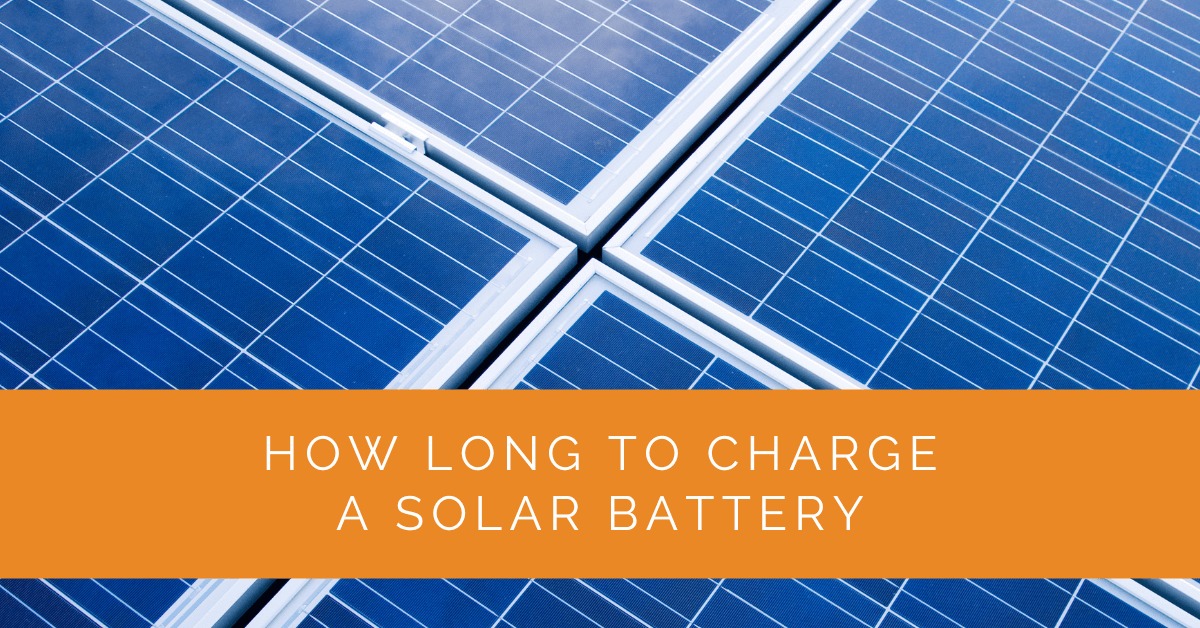Solar batteries play a crucial role in solar power systems, storing energy generated by solar panels for later use. Before delving into solar batteries’ charge time, let’s better understand their significance and the factors that influence their charging process.
Contents
- 1 Key Takeaways
- 2 Different Types of Solar Batteries
- 3 Factors Affecting Solar Battery Charge Time
- 4 Determining Solar Battery Charge Time
- 5 Optimizing Solar Battery Charging
- 6 Case Study: Optimizing Solar Battery Charging for Enhanced Performance
- 7 Expert Insights From Our Solar Panel Installers About How Long to Charge a Solar Battery
- 8 Experience Solar Excellence with Us!
- 9 Conclusion
Key Takeaways
- The charge time of a solar battery is influenced by factors such as battery capacity, charge rate, solar panel output, and charging efficiency.
- Optimizing solar battery charging involves considering factors like battery chemistry, environmental conditions, and proper maintenance to enhance charging efficiency and shorten charge times.
- Understanding the importance of solar batteries, the different types available, and strategies for optimizing charging can help maximize the efficiency of your solar power system.
The Importance of Solar Batteries in Solar Power Systems
Solar batteries play a pivotal role in solar power systems by providing a means to store and utilize the energy generated by solar panels. They enable homeowners and businesses to optimize their solar energy usage, reduce reliance on the grid, and achieve energy independence. Here are some key aspects highlighting the importance of solar batteries:
- Energy Storage: Solar batteries act as a reservoir for surplus energy generated during periods of high solar production. This stored energy can be used during low solar generation or high energy demand, such as at night or on cloudy days. Solar batteries ensure a consistent and reliable power supply by storing excess energy.
- Energy Independence: Solar batteries empower users to become less dependent on the traditional power grid. With sufficient battery capacity, solar power systems can meet a substantial portion of the energy needs even when the grid is unavailable or during power outages. This enhances self-sufficiency and resilience, particularly in remote areas or during emergencies.
- Peak Load Management: Solar batteries assist in managing peak energy loads efficiently. During times of high energy demand, such as evenings when people return home and electricity usage surges, solar batteries can discharge stored energy to alleviate strain on the grid. This helps reduce the strain on power infrastructure and ensures a reliable energy supply during peak periods.
- Time-of-Use Optimization: Solar batteries can shift energy consumption to off-peak hours in regions with time-of-use (TOU) electricity pricing. By charging the batteries when electricity rates are low and discharging them during high-rate periods, users can optimize their energy costs and save money on their electricity bills.
- Grid Support and Stability: Solar batteries contribute to grid stability and support by integrating renewable energy into the existing power infrastructure. By storing excess solar energy and feeding it back to the grid when needed, solar battery systems help balance supply and demand, reduce transmission losses, and enhance the overall reliability of the grid.
Different Types of Solar Batteries
Several types of solar batteries are available, each with its own characteristics, performance, and suitability for specific applications. Here are some of the commonly used types of solar batteries:
- Lithium-ion Batteries: Lithium-ion batteries are highly regarded for their energy density, efficiency, and long lifespan. They offer a higher charge acceptance rate, allowing faster charging times than other battery types. Lithium-ion batteries are lightweight, compact, and often used in residential and commercial solar power systems.
- Lead-acid Batteries: Lead-acid batteries have been widely used in various applications, including solar power systems. They are cost-effective and available in two main variants: flooded lead-acid (FLA) and sealed lead-acid (SLA) batteries. FLA batteries require periodic maintenance and proper ventilation, while SLA batteries are maintenance-free and can be installed in any orientation.
- Deep Cycle Batteries: Deep cycle batteries are specifically designed for repetitive discharging and recharging cycles. They are commonly used in solar power systems due to their durability and ability to withstand regular deep discharges without compromising performance. Deep-cycle batteries are available in various chemistries, including lead-acid and lithium-ion.
- Saltwater Batteries: Saltwater batteries, also known as saltwater or seawater batteries, are an emerging technology in the solar battery market. They utilize a saltwater electrolyte solution, making them more environmentally friendly than other battery types. Saltwater batteries offer safe operation, long cycle life, and are recyclable.

Factors Affecting Solar Battery Charge Time
The charging time of a solar battery depends on several factors that influence the overall charging process. Understanding these factors is essential for effectively estimating the time to charge a solar battery. Here are the key factors to consider:
- Battery Capacity: The capacity of a solar battery, measured in ampere-hours (Ah), determines the amount of energy it can store. Generally, higher-capacity batteries take longer to charge than lower-capacity ones, assuming the charging conditions remain constant.
- Charge Rate: The charge rate, measured in amperes (A), indicates how quickly a battery can accept the charging current. Higher charge rates enable faster charging, but it’s important to ensure that the charging rate does not exceed the battery manufacturer’s recommendations to avoid damage.
- Solar Panel Output: The power output of solar panels, measured in watts (W), directly impacts the charging time of a solar battery. Higher-wattage panels generate more energy, resulting in faster charging times. Additionally, efficient solar panels with higher conversion efficiencies can capture and convert more sunlight into electricity, reducing charge times.
- Charging Efficiency: Charging efficiency refers to how effectively the energy from solar panels is converted and stored in the battery. Factors such as the quality of charge controllers, cable losses, and system wiring affect charging efficiency. High-quality components and proper system design contribute to optimal charging efficiency and shorter charge times.
- Environmental Conditions: Environmental factors, including temperature and sunlight intensity, play a role in the charging time of solar batteries. Solar panels operate most efficiently under direct sunlight, while lower light conditions, such as cloudy days, can extend the charging duration. Temperature extremes, especially high temperatures, can affect battery performance and charging efficiency.
- Battery Chemistry: Different battery chemistries have varying charge acceptance rates and charging characteristics. For example, lithium-ion batteries typically have higher charge acceptance rates and can be charged more quickly than lead-acid batteries. Understanding the specific charging requirements of the battery chemistry is crucial for optimizing the charging time.
- Charge Controllers: Charge controllers, such as solar charge controllers, regulate the charging process, ensuring the battery receives the appropriate charge current and voltage. Advanced charge controllers utilize Maximum Power Point Tracking (MPPT) technology to optimize solar panel output and enhance charging efficiency, leading to shorter charge times.
In the next sections, we will delve into how to determine the charge time of a solar battery and strategies for optimizing solar battery charging.

Determining Solar Battery Charge Time
Several factors need to be considered to estimate the charge time of a solar battery accurately. Considering these factors, you can determine how long it takes to charge your solar battery fully. Here are the key aspects to consider:
Battery Capacity and Charge Rate
The capacity of a solar battery is a crucial factor in determining the charge time. It represents the total amount of energy the battery can store. A higher-capacity battery will take longer to charge than a lower-capacity one, assuming the charging conditions remain constant.
The charge rate, on the other hand, indicates how quickly the battery can accept the charging current. It is essential to ensure the charging rate does not exceed the battery manufacturer’s recommendations to avoid damage. Balancing the charge rate with the battery capacity is vital to optimize the charging time.
Solar Panel Output and Charging Efficiency
Solar panels’ power output directly affects a solar battery’s charging time. Higher-wattage panels generate more energy, leading to faster charging times. Additionally, using efficient solar panels with higher conversion efficiencies ensures that more sunlight is converted into electricity, reducing the charge time.
Charging efficiency is another critical factor to consider. Efficient charge controllers and proper system design maximize the energy transfer from the solar panels to the battery. Minimizing losses and optimizing the charging process can improve charging efficiency, resulting in shorter charge times.
Battery Chemistry and Voltage Compatibility
Different battery chemistries have varying charge acceptance rates and requirements. For example, lithium-ion batteries typically have higher charge acceptance rates and can be charged more quickly than lead-acid batteries. It is important to understand the specific charging requirements and limitations of the battery chemistry you are using to optimize the charging time.
Additionally, ensuring compatibility between the battery voltage and the solar panel system is crucial. The solar panels’ voltage output should match the battery’s charging voltage requirements. Using mismatched voltages can result in inefficient charging and longer charge times.
Charging Environment and Conditions
The charging environment and conditions also influence the charge time of a solar battery. Factors such as temperature and sunlight intensity play a significant role. Solar panels operate most efficiently under direct sunlight, while lower light conditions, such as cloudy days, can extend the charging duration.
Extreme temperatures, especially high temperatures, can affect battery performance and charging efficiency. Monitoring the temperature and ensuring the battery remains within the recommended operating range for optimal charging is important. Maintaining proper ventilation around the battery and avoiding excessive heat exposure can help optimize the charge time.

Optimizing Solar Battery Charging
Efficiently charging solar batteries is essential for their longevity and optimal performance. By implementing the following strategies, you can optimize the charging process and maximize the efficiency of your solar power system:
Proper Battery Maintenance and Care
Regular maintenance, such as cleaning solar panels, checking battery connections, and monitoring charge levels, enhances charging efficiency. It is important to monitor the battery’s state of charge and voltage to ensure it remains within the recommended range. Additionally, following the manufacturer’s battery maintenance and care guidelines can prolong its lifespan and optimize its charging performance.
Choosing the Right Solar Battery for Your System
Selecting the appropriate solar battery for your specific needs is crucial. Consider factors such as battery capacity, cycle life, and compatibility with your solar power system. Opting for high-quality batteries from reputable manufacturers can contribute to more efficient charging and longer battery lifespan.
Considerations for Off-Grid vs. Grid-Tied Systems
The dynamics of charging differ for off-grid and grid-tied solar power systems. Off-grid systems rely solely on solar power and require sufficient battery capacity to meet energy demands during periods of low sunlight. Grid-tied systems, on the other hand, may prioritize feeding excess energy back to the grid rather than storing it in batteries. Understanding the specific requirements of your system and tailoring the charging approach accordingly can optimize the charging time.
Balancing Power Needs and Battery Charging Time
It is essential to analyze your power consumption patterns and balance them with battery charging time. By understanding your energy requirements and optimizing battery charging cycles, you can balance meeting immediate power needs and ensuring adequate battery charging. This ensures optimal use of solar energy and minimizes reliance on the grid during periods of low solar generation.
Case Study: Optimizing Solar Battery Charging for Enhanced Performance
Background
Solar Panels Network USA recently undertook a project to optimize the charging process for solar batteries in a residential solar power system. The goal was to enhance charging efficiency, reduce charge times, and ensure reliable energy storage for the homeowner.
Project Overview
The homeowner had a solar power system with a mix of lithium-ion and lead-acid batteries. They faced challenges with long charging times and inefficient energy storage, particularly during periods of low sunlight. Our task was to evaluate the system and implement strategies to optimize the battery charging process.
Implementation
System Evaluation and Analysis
We started by conducting a comprehensive assessment of the existing solar power system. This included analyzing the battery capacities, charge rates, solar panel output, and overall system design. We also evaluated environmental factors such as roof orientation, shading, and typical sunlight exposure.
Upgrading Charge Controllers
To enhance the charging efficiency, we recommended upgrading the existing charge controllers to ones equipped with Maximum Power Point Tracking (MPPT) technology. MPPT charge controllers optimize the power output from the solar panels, ensuring maximum energy is extracted and stored in the batteries.
Improving Solar Panel Output
We identified areas for improving the solar panel output by repositioning certain panels to reduce shading and enhance sunlight exposure. Additionally, we recommended cleaning the panels regularly to maintain optimal performance and energy capture.
Battery Maintenance and Monitoring
Proper maintenance and monitoring of the batteries were essential for improving charging efficiency. We implemented a regular maintenance schedule that included checking battery connections, monitoring charge levels, and ensuring the batteries operated within the recommended temperature range.
Optimizing System Design
We redesigned the system layout to balance the load and charging demands more effectively. This involved adjusting the configuration to ensure that both lithium-ion and lead-acid batteries received appropriate charge rates without overloading any single component.
Environmental Considerations
Given the impact of environmental conditions on charging times, we recommended installing shading analysis tools and temperature monitoring systems. These tools helped in making real-time adjustments to the system, ensuring optimal performance even under varying environmental conditions.
Results
The implementation of these strategies resulted in a significant reduction in solar battery charging times. The use of MPPT charge controllers, coupled with optimized solar panel output and regular maintenance, enhanced the overall charging efficiency. The homeowner experienced improved energy storage, leading to greater energy independence and reliability.
Summary
This case study demonstrates the importance of a holistic approach to optimizing solar battery charging. By upgrading charge controllers, improving solar panel output, maintaining batteries properly, and considering environmental factors, Solar Panels Network USA successfully reduced charging times and enhanced system performance. These strategies ensure efficient energy storage and a reliable power supply, contributing to the overall effectiveness of the solar power system.
Expert Insights From Our Solar Panel Installers About How Long to Charge a Solar Battery
Understanding the capacity and chemistry of your solar battery is crucial for estimating charge times accurately. Lithium-ion batteries, for example, generally charge faster and more efficiently compared to lead-acid batteries.
Senior Solar Technician
Efficient charge controllers play a significant role in optimizing the charging process. Utilizing MPPT technology can significantly reduce charge times by ensuring maximum power extraction from the solar panels.
Lead Solar Engineer
Environmental conditions, especially temperature and sunlight intensity, can drastically affect charging times. Proper system design and maintenance help mitigate these factors and enhance overall charging efficiency.
Solar System Designer
Experience Solar Excellence with Us!
Trust in Solar Panels Network USA, where our seasoned experts deliver top-quality solar solutions for homes and businesses nationwide. With a legacy of countless successful installations and a commitment to sustainable energy, we’re your reliable partner in the solar journey. Ready for a brighter, eco-friendly future? Call us now at (855) 427-0058 and harness the power of the sun!
Conclusion
The charging time of a solar battery depends on various factors, including battery capacity, charge rate, solar panel output, and charging efficiency. By considering these factors and implementing optimization strategies, you can estimate the charging time and maximize the efficiency of your solar power system. Efficient charging ensures a reliable and sustainable energy supply, enhancing the overall performance of your solar power system.
About the Author
Solar Panels Network USA stands at the forefront of solar energy solutions, driven by a team of seasoned solar engineers and energy consultants. With over decades of experience in delivering high-quality solar installations and maintenance, we are committed to promoting sustainable energy through customer-centric, tailored solutions. Our articles reflect this commitment, crafted collaboratively by experts to provide accurate, up-to-date insights into solar technology, ensuring our readers are well-informed and empowered in their solar energy decisions.

